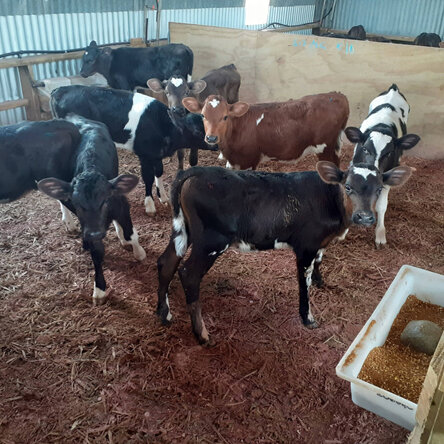Franklin Vets
Franklin Vets - excellence in veterinary care for dairy, farming, lifestyle, equine and household pets. BESTPRACTICE ACCREDITED NZ.
Your account is powered by Storbie. To edit your profile visit my.storbie.com
Your account is powered by Storbie. To edit your profile visit my.storbie.com

Consumer pressure is increasing and in an effort to stay ahead of the curve, all dairy animals must be seen to have a ‘useful’ life. This is achieved by entering one of three secondary value streams – bull beef, veal or pet food.
Euthanasia on-farm can still be performed but only under specific circumstances; If calves are unable to be reared on farm and petfood, calf meat or sale for rearing is not available or if humane euthanasia is required. Reasons for humane euthanasia are defined as;
Calves are still not able to be transported until they are 4 days old so shed space may be an important consideration. Each calf requires a minimum of 1.5-2m2 and there should ideally be no more than 10-15 per pen. All calves should have 3-4L of good quality colostrum (at least 10% of their body weight) within the first 12 hours of life which may require tube feeding.
Planning for this change involved the selection of bulls for the 2022/23 mating season – what bulls were used and how do they fit into the alternative value streams? Careful consideration is required around which alternative stream fits your system – one or a combination? Will calves be sold at four days old or later? It may be tempting to go straight for a beef breed but don’t forget to consider other factors such as calving ease to prevent animal health compromise elsewhere.
Consider the viability of heifer synchrony for your system to reduce non-replacement calves. If your heifers are well grown, reaching 60% of target mature live-weight at mating, then using synchrony with AI results in the highest genetic value replacements possible from your herd. Heifers are generally the animals in the herd with the greatest genetic value therefore using them to generate replacement calves speeds up your rate of genetic gain in the herd. Select bulls with high calving ease BVs to put over heifers.
Sexed semen can be a useful tool to reduce the number of bull calves being born and increase replacement heifers. Keep in mind that sexed semen does have a slightly lower conception rate as a result of the sorting process so this may not be a useful option if your herd is struggling with reproductive performance.
There are several tools in the toolbox to manage non-replacement calves, several of which are likely already in place on your farm. Get in touch with your veterinarian to discuss potential programs that may be beneficial for your herd.
Dr Leah Wakeford - Farm Vet & Branch Manager, Waihi
Franklin Vets - excellence in veterinary care for dairy, farming, lifestyle, equine and household pets. BESTPRACTICE ACCREDITED NZ.



